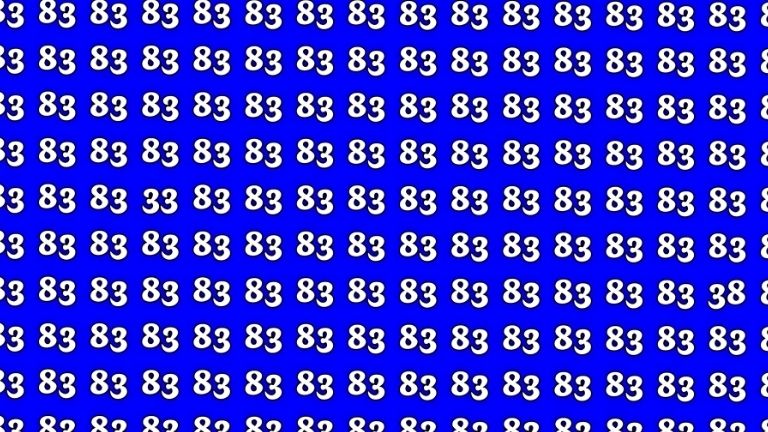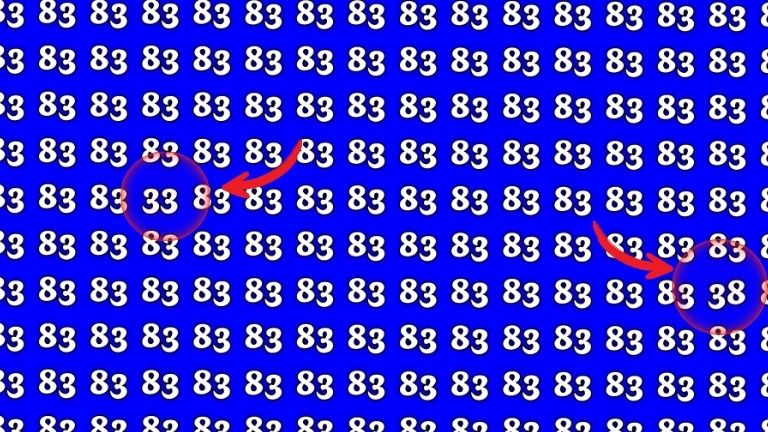Have you ever wondered why some people can instantly spot hidden details while others struggle for minutes? The latest viral optical illusion challenge is putting everyone’s visual skills to the test. This mind-bending puzzle asks you to find the numbers 38 and 33 cleverly concealed among a sea of 83s in just seven seconds.
People across social media platforms are sharing their results, creating a global competition of visual prowess. Some claim they can spot both numbers instantly, while others admit defeat after staring for several minutes.
What Makes This Optical Illusion So Challenging?
The human brain processes visual information in fascinating ways that often surprise us. When we look at similar-looking numbers like 83, 38, and 33, our minds tend to see patterns rather than individual digits. This phenomenon occurs because our brain tries to simplify complex visual information.
The Science Behind Number Recognition
Your brain recognizes numbers through a process called pattern matching. When surrounded by dozens of identical 83s, the slightly different 38 and 33 become camouflaged. The similar shapes of these digits – especially the curves of 8 and 3 – make them blend together seamlessly.
Research shows that our visual system prioritizes speed over accuracy when processing information. This evolutionary trait helped our ancestors quickly identify threats, but it makes modern puzzles more challenging. The brain assumes that if most elements look similar, they probably are identical.

Why Seven Seconds Matters
The seven-second time limit isn’t arbitrary – it’s based on cognitive science research. Studies indicate that initial visual processing happens within the first few seconds of viewing an image. After this period, your brain starts using different strategies, including systematic searching rather than intuitive recognition.
Professional puzzle solvers know that first impressions often yield the best results. Your subconscious mind can sometimes spot anomalies faster than your conscious analytical thinking. However, this requires training your visual perception skills through regular practice.
Proven Strategies to Master This Challenge
Success in this optical illusion requires more than just good eyesight. You need specific techniques that work with your brain’s natural processing patterns. Here are methods that consistently help people find both hidden numbers quickly.
The Scanning Technique
Instead of trying to see everything at once, use systematic scanning patterns. Start from the top-left corner and move your eyes in horizontal lines across the image. This methodical approach prevents your brain from getting overwhelmed by too much visual information simultaneously.
Many successful puzzle solvers report better results when they avoid focusing intensely on individual numbers. Let your peripheral vision do the work while maintaining a relaxed gaze. This technique allows your brain to notice subtle differences more effectively.
The Defocus Method
Sometimes looking too hard actually makes finding hidden elements more difficult. Try slightly unfocusing your eyeswhile viewing the puzzle. This technique helps different-shaped numbers stand out from the uniform pattern of 83s.
Professional magicians and visual artists often use this method to spot irregularities in complex patterns. The defocused approach allows your brain to process overall shapes rather than getting caught up in individual digit details.
Common Mistakes That Slow You Down
Understanding what doesn’t work is just as important as knowing effective strategies. Many people make predictable errors that significantly increase their solving time.
The Overthinking Trap
One major mistake is analyzing each number individually. When you examine every 83 carefully, you’re working against your brain’s natural pattern recognition abilities. This approach takes far longer than seven seconds and often leads to missing the hidden numbers entirely.
Another common error involves second-guessing your initial instincts. If you think you’ve spotted 38 or 33, trust that first impression. Many people correctly identify the location but then convince themselves they’re wrong.
Wrong Visual Strategies
Some people try to squint or strain their eyes, thinking this will help them see better. Actually, this technique often makes the task harder by reducing your overall visual field. Relaxed, natural vision typically produces better results than forced focusing.
Moving your head or the device while viewing also disrupts the pattern recognition process. Keep both your head and the image steady for optimal results. Any movement creates additional visual noise that your brain must filter out.
The Psychology Behind Visual Perception
Understanding why this challenge works reveals fascinating insights about human cognition. Our brains are remarkably sophisticated at processing visual information, but they also have predictable limitations.
Pattern Recognition and Expectation
Your mind creates expectations based on context. When you see multiple 83s, your brain anticipates that all numbers will be 83. This expectation makes it harder to notice the different numbers, even when they’re clearly visible.
This same principle explains why proofreading your own writing is difficult – your brain sees what it expects rather than what’s actually there. The optical illusion exploits this natural tendency to make the challenge more engaging.
Attention and Focus Distribution
Research in cognitive psychology shows that attention works like a spotlight with limited coverage area. When you focus intensely on one section of the puzzle, you might miss obvious answers in other areas. Successful puzzle solvers learn to distribute their attention more evenly.
The challenge also tests your ability to switch between different types of attention. Finding hidden numbers requires both broad awareness and detailed recognition – skills that improve with practice.
Training Your Visual Skills
Like any ability, visual perception can be improved through targeted practice. Regular exposure to optical illusions and visual puzzles enhances your pattern recognition capabilities.
Daily Practice Routines
Spend five minutes daily working on different types of visual puzzles. Start with simpler challenges and gradually increase difficulty. This progressive approach builds your visual processing skills without causing frustration.
Try puzzles that involve finding differences, hidden objects, or pattern completion. Each type exercises different aspects of visual perception. Variety in your practice routine prevents your skills from becoming too specialized.
Building Peripheral Vision
Strong peripheral vision significantly improves performance on challenges like this. Practice exercises that require you to notice changes or movements at the edges of your visual field. Simple activities like catching balls or playing certain video games can help develop these skills.
Many athletes and pilots have exceptional peripheral vision due to their training requirements. While most people don’t need professional-level skills, even modest improvements make visual puzzles much easier.
The Social Media Phenomenon
This particular optical illusion has gained massive popularity across various social platforms. Understanding why certain puzzles go viral reveals interesting aspects of human psychology and social behavior.
The Challenge Culture
Modern social media thrives on shareable challenges that people can attempt quickly. The seven-second time limit makes this puzzle perfect for short attention spans while still providing meaningful difficulty. People enjoy testing themselves and comparing results with friends.
The binary nature of success (you either find them or you don’t) creates clear outcomes that are easy to discuss. Unlike subjective content, optical illusions generate objective results that spark genuine conversation and competition.
Psychological Satisfaction
Successfully solving visual puzzles triggers dopamine release in the brain – the same neurotransmitter associated with other rewarding activities. This natural high explains why people become addicted to puzzle-solving and eagerly seek out new challenges.
The brief time investment makes failure less frustrating while success feels more significant. Seven seconds isn’t long enough to feel genuinely upset about not finding the numbers, but it’s sufficient time to feel accomplished when you succeed.
Advanced Techniques for Expert Level
Once you’ve mastered the basic strategies, advanced techniques can help you tackle even more challenging visual puzzles. These methods require practice but significantly improve your overall puzzle-solving abilities.
The Grid Method
Mentally divide complex images into smaller grid sections. Examine each section briefly before moving to the next. This systematic approach ensures you don’t miss any areas while preventing visual overload from trying to process everything simultaneously.
Professional photo editors and quality control inspectors use similar techniques in their work. The grid method works because it manages cognitive load while maintaining thoroughness.
Color and Contrast Awareness
Even in black and white puzzles, subtle shade differences can provide clues. The printing or display process sometimes creates slight variations that make hidden elements stand out. Train yourself to notice these subtle contrasts.
This skill becomes particularly valuable in more complex optical illusions that use color, shading, or texture variations. Building general contrast sensitivity helps with all types of visual puzzles.
Health Benefits of Visual Puzzles
Regular engagement with optical illusions and visual challenges provides several cognitive and health benefits beyond entertainment value.
Cognitive Enhancement
Visual puzzles exercise multiple brain regions simultaneously. Pattern recognition, attention control, and spatial processing all improve through regular practice. These skills transfer to other activities and may help maintain cognitive function as you age.
Studies suggest that people who regularly engage in visual puzzles show better visual memory and faster information processing speeds. While more research is needed, early results are encouraging for puzzle enthusiasts.
Stress Reduction and Focus
The focused attention required for visual puzzles can provide meditative benefits. Like mindfulness practices, puzzle-solving requires present-moment awareness that can reduce anxiety and racing thoughts.
Many people find that brief puzzle sessions help them reset mentally during busy days. The seven-second format makes these benefits accessible even during short breaks.
Creating Your Own Visual Challenges
Understanding how this optical illusion works enables you to create similar challenges for friends and family. Designing effective visual puzzles requires balancing difficulty with solvability.
Design Principles
Effective hidden number puzzles need sufficient similarity between the target and background elements. Too much difference makes the challenge too easy, while too much similarity makes it impossibly difficult. The 83, 38, 33 combination works well because of shared digits and similar shapes.
Consider font choice, size, and spacing carefully. These factors dramatically affect difficulty level. Test your creations with different people to ensure appropriate challenge levels.
Digital Tools and Techniques
Modern graphic design software makes creating custom optical illusions relatively straightforward. Even basic programs can generate effective number-hiding puzzles. Experiment with different layouts, fonts, and arrangements to find combinations that work well.
Share your creations on social media to test their effectiveness. User feedback helps you refine your design skills and create more engaging challenges.
Frequently Asked Questions
Q: How long should I spend trying to find the hidden numbers? Don’t exceed 30 seconds of intense searching, as this can cause eye strain and frustration.
Q: Is it normal if I can’t find both numbers immediately? Yes, many people need multiple attempts to develop the necessary visual skills for quick recognition.
Q: Do these puzzles help improve overall vision? They enhance visual processing skills but don’t improve actual eyesight or correct vision problems.
Q: Why do some people find these challenges easier than others? Individual differences in visual processing, attention, and experience with similar puzzles affect performance.
Q: Can children benefit from optical illusion challenges? Yes, age-appropriate visual puzzles can help develop important cognitive and visual skills in children.
Q: Are there any risks to doing too many visual puzzles? Extended sessions may cause eye fatigue, so take regular breaks and maintain proper lighting.
Q: Do prescription glasses affect performance on these challenges? Proper vision correction typically improves performance rather than hindering it.
Q: Why do the numbers 83, 38, and 33 work well together? The shared digits and similar curves create effective camouflage while maintaining distinguishable differences.
Q: Can these skills transfer to real-world situations? Yes, improved visual attention and pattern recognition have practical applications in many activities.
Q: How often should I practice visual puzzles for improvement? Short daily sessions of 5-10 minutes typically provide steady improvement without causing fatigue.
